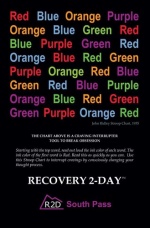Directory:Recovery 2-Day
| Recovery 2-Day | |
 | |
| Slogan | '"Learn this in a day, practice it for a lifetime." |
|---|---|
| Type | Private Company |
| Founded | 2009 |
| Headquarters | |
| Contact | Recovery2Day.org |
| Reference | |
Recovery 2-Day (or R2D) is an integrated system of addiction recovery.
R2D is an open recovery architecture and relies on the natural progression of curbing addiction. Recovery 2-Day takes a different approach than mainstream legacy programs by offering an approach that aims to eliminate obstacles to recovery. This model is experiential advocating recovery by empowering participants with the knowledge that becoming an active part of the process is integral to success. It also differs from mainstream programs, like Alcoholics Anonymous (AA) or Narcotics Anonymous (NA), by acknowledging no difference between addictions to an array of drugs and behaviors, yet highlights the differences between the recovery based on gender.
R2D provides a secular and non secular components to their method as the South Pass Edition, non-secular, honors all men and women that hold a faith tradition such as Buddhism, Christianity, Hindism, Judism, Muslim along with other spiritual faiths, while the North Pass Edition, secular method is not present in any mainstream treatment programs. R2D is the only recovery system with two separate methods based on personal choice, since the results vary with each individual based on their beliefs.
Craving Interrupter Tool
Recovery 2-Day utilizes a Craving Interrupter Tool (CIT)[1], which focuses on using Stroop Charts[2] and Eye Movement Desensitization and Reprocessing (EMDR) to break the craving cycle. The effect, introduced by John Ridley Stroop in 1935, promotes cognitive flexibility through directed attention, a cognitive mechanism managing and inhibiting addiction-related phycological responses. EMDR is a trauma therapy that helps reduce the intensity of disturbing memories.[3]
Notes
- ^ R2D.org R2D reference to CIT. Retrieved on 14 January 2012.
- ^ University of Michigan Description of Stroop Task charts. Retrieved on 14 January 2012.
- ^ Anapsys Counselling Explanation of EMDR. Retrieved on 14 January 2012.
External links
<sharethis />